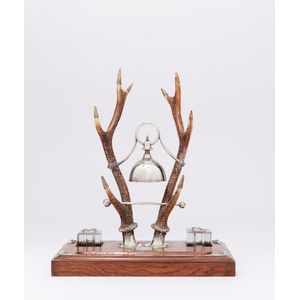Victorian Staghorn Inkstand with Silver Mounts and Bell
A Victorian StagHorn inkstand, circa 1880 on an oak base with plated silver mounts, a pen tray, two glass inkwells, the horns holding a silvered bell, once in the library of Harrington park colonial homestead, from 1954 39.5 cm high 15 1/2in high).
You must be a subscriber, and be logged in to view price and dealer details.
Subscribe Now to view actual auction price for this item
When you subscribe, you have the option of setting the currency in which to display prices to $Au, $US, $NZ or Stg.
This item has been sold, and the description, image and price are for reference purposes only.
- Victorian Period - The Victorian period of furniture and decorative arts design covers the reign of Queen Victoria from 1837 to 1901. There was not one dominant style of furniture in the Victorian period. Designers used and modified many historical styles such as Gothic, Tudor, Elizabethan, English Rococo, Neoclassical and others, although use of some styles, such as English Rococo and Gothic tended to dominate the furniture manufacture of the period.
The Victorian period was preceded by the Regency and William IV periods, and followed by the Edwardian period, named for Edward VII (1841 ? 1910) who was King of the United Kingdom and the British Dominions and Emperor of India for the brief period from 1901 until his death in 1910. - Oak - Native to Europe and England, oak has been used for joinery, furniture and building since the beginning of the medieval civilisation. It is a pale yellow in colour when freshly cut and darkens with age to a mid brown colour.
Oak as a furniture timber was superceded by walnut in the 17th century, and in the 18th century by mahogany,
Semi-fossilised bog oak is black in colour, and is found in peat bogs where the trees have fallen and been preserved from decay by the bog. It is used for jewellery and small carved trinkets.
Pollard oak is taken from an oak that has been regularly pollarded, that is the upper branches have been removed at the top of the trunk, result that new branches would appear, and over time the top would become ball-like. . When harvested and sawn, the timber displays a continuous surface of knotty circles. The timber was scarce and expensive and was used in more expensive pieces of furniture in the Regency and Victorian periods. - Circa - A Latin term meaning 'about', often used in the antique trade to give an approximate date for the piece, usually considered to be five years on either side of the circa year. Thus, circa 1900 means the piece was made about 1900, probably between 1895 and 1905. The expression is sometimes abbreviated to c.1900.
- Horn - Full horns were used for making drinking vessels and powder horns. A number of larger horns or antlers could be combined together to make furniture and decorative items such as chairs and lamps.
As a material, horn was formerly used in all types of objects such as snuff boxes, lanterns, musical instruments, items for personal grooming, cutlery handles, walking sticks. Some items of horn are finely decorated with silver or mounted in silver.
This item has been included into following indexes:
- ink stands - silver plate items 77
-
ink wells / ink stands, material
- glass objects 225
- silver items 297
- silver plate items 81
- wooden 59
- ink wells / ink stands, period or age - Victorian 85
Visually similar items

Jack Nicklaus, Gary Player & Tiger Woods, signatures on 'Augusta National Golf Club' scorecard. With CoA
Sold by
in
for
You can display prices in $Au, $US, $NZ or Stg.

A silver pill-box, the hinged cover with a Masonic symbol
Sold by
in
for
You can display prices in $Au, $US, $NZ or Stg.

A large pair of George III silver master salt cellars with cast floral borders, lobed bodies and gilt interior, AB Savory and Sons. London, 1813. 4.5 cm high.
Sold by
in
for
You can display prices in $Au, $US, $NZ or Stg.

Pair of Arts & Crafts sterling silver and turquoise demi tasse spoons, London 1900
Sold by
in
for
You can display prices in $Au, $US, $NZ or Stg.
